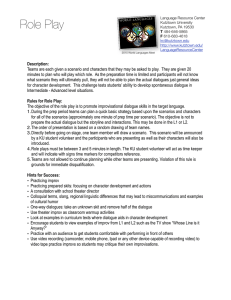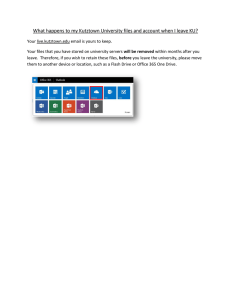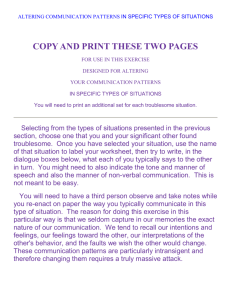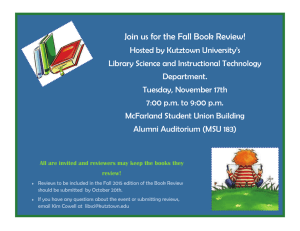Role Play
advertisement
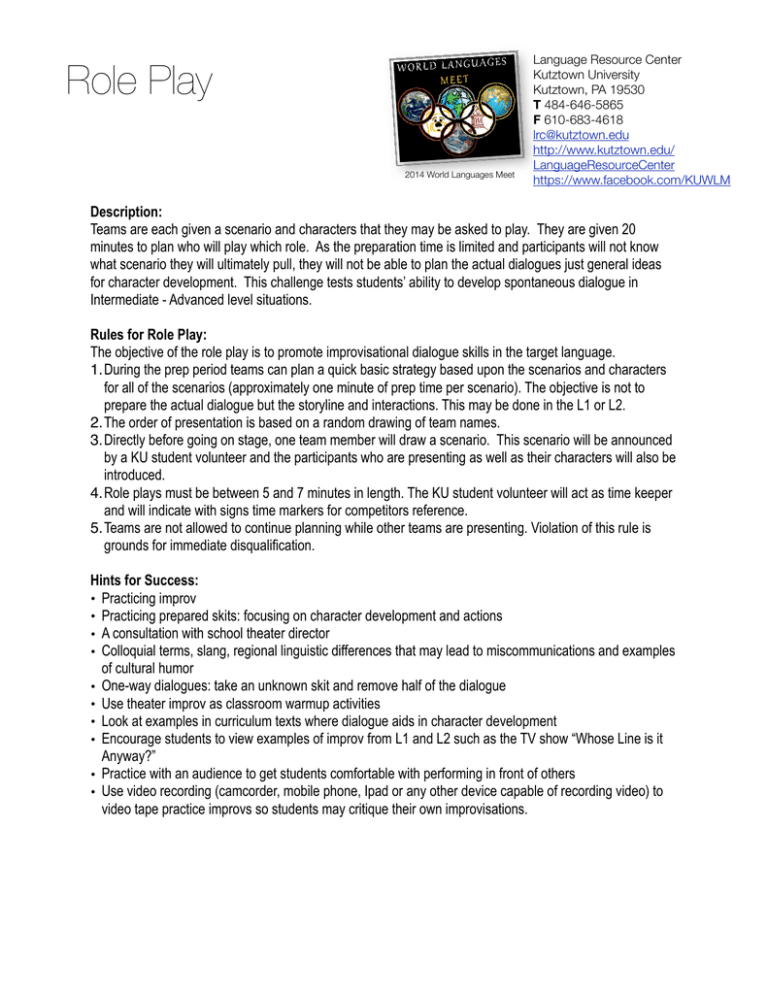
Role Play 2014 World Languages Meet Language Resource Center Kutztown University Kutztown, PA 19530 T 484-646-5865 F 610-683-4618 lrc@kutztown.edu http://www.kutztown.edu/ LanguageResourceCenter https://www.facebook.com/KUWLM Description: Teams are each given a scenario and characters that they may be asked to play. They are given 20 minutes to plan who will play which role. As the preparation time is limited and participants will not know what scenario they will ultimately pull, they will not be able to plan the actual dialogues just general ideas for character development. This challenge tests students’ ability to develop spontaneous dialogue in Intermediate - Advanced level situations. Rules for Role Play: The objective of the role play is to promote improvisational dialogue skills in the target language. 1.During the prep period teams can plan a quick basic strategy based upon the scenarios and characters for all of the scenarios (approximately one minute of prep time per scenario). The objective is not to prepare the actual dialogue but the storyline and interactions. This may be done in the L1 or L2. 2.The order of presentation is based on a random drawing of team names. 3.Directly before going on stage, one team member will draw a scenario. This scenario will be announced by a KU student volunteer and the participants who are presenting as well as their characters will also be introduced. 4.Role plays must be between 5 and 7 minutes in length. The KU student volunteer will act as time keeper and will indicate with signs time markers for competitors reference. 5.Teams are not allowed to continue planning while other teams are presenting. Violation of this rule is grounds for immediate disqualification. Hints for Success: • Practicing improv • Practicing prepared skits: focusing on character development and actions • A consultation with school theater director • Colloquial terms, slang, regional linguistic differences that may lead to miscommunications and examples of cultural humor • One-way dialogues: take an unknown skit and remove half of the dialogue • Use theater improv as classroom warmup activities • Look at examples in curriculum texts where dialogue aids in character development • Encourage students to view examples of improv from L1 and L2 such as the TV show “Whose Line is it Anyway?” • Practice with an audience to get students comfortable with performing in front of others • Use video recording (camcorder, mobile phone, Ipad or any other device capable of recording video) to video tape practice improvs so students may critique their own improvisations. Rubric: Criteria Excellent 5 Good 4 Fair 3 Poor 2 Language Use Students easily and appropriately make use of the past and present tenses. Students have control of grammatical structure and can circumlocute when needed. Students make occasional errors in tense use or complex grammatical structures. May struggle to circumlocute but can convey the message through other paralinguistic cues. Students make frequent errors in grammatical structures or vocabulary that do not impact the overall communication of meaning. Language is predominately simple in form and vocabulary. Students make errors in grammatical structure or vocabulary that interfere with the communication of meaning or make use of the L1. Participation in Preparation and Presentation Actively involved in the dialogue and reactive to other characters. Little to no hesitation to participate from any member. All characters have a defined speaking role but show minimal reactions to other characters. Some characters are not as actively involved as others in the dialogue and are reluctant to participate. Dialogue is dominated by only one or two characters and there is a lack of team approach. Presentation Convincing of Character communication of characters’ feelings, situations and motives. Adequate communication of Frequent breakdowns characters’ feelings, in the communication situations and motives. of characters’ feelings, situations and motives. Little to no attempt to communicate characters’ feelings, situations and motives. Achievement Students effectively Students accomplish the of Purpose accomplish the task task to a minimal required by the scenario requirement. in the required time frame. Students fail to present a crucial aspect of the task or do not fill the time requirement. No attention given to accomplishing tasks set out be scenario. Use of NonVerbal Cues (gestures, eye contact, props, physical reactions to others’ speech) Satisfactory variety of non-verbal cues used in an acceptable way. Limited variety of non-verbal cues are used in a developing way. Total Impressive variety of non-verbal cues are used in an exemplary way. Good variety of non-verbal cues are used in a competent way.
